“Rateb Samour sees 250 patients a day whose complaints range from hair loss to cerebral palsy and cancer. But he is not a doctor and has never worked in a hospital. Samour inherited the skill of bee-sting therapy from his father, who used to raise bees. Then in 2003, the agricultural engineer started to dedicate all his time to studying and developing the alternative medicine treatment of apitherapy, which uses all bee-related products, including honey, propolis – or bee glue used to build hives – and venom. “I am treating serious and chronic diseases which have no cure in regular medicine, I have achieved excellent results”, said Samour, an Egyptian-educated specialist in entomology and bees in the Gaza Strip, a Palestinian enclave. “We speak about chondritis in the neck and spine, migraine, loss of hair, alopecia areata, skin diseases, cerebral palsy, autism and cancer”, he said inside an apartment packed with patients on the edge of a beach refugee camp in Gaza City. The 58-year-old Palestinian said he makes bees sting patients at certain points in their bodies that he has carefully studied. A bee dies after being made to sting. “I have been subjected to doubts, but bee-sting therapy has proven itself as an excellent alternative medicine”, he told Reuters. “Some doctors, who value the apitherapy for certain illnesses, are among my patients”. The Islamist-ruled Gaza is under blockade by neighboring Egypt and Israel, which restricts the movement of goods and people in and out of the territory. So Gaza lacks sophisticated medical equipment and has patchy access to medicines. Seriously ill patients must travel to Israel, Egypt or beyond for specialist medical treatment”. – Nidal al-Mughrabi via Reuters
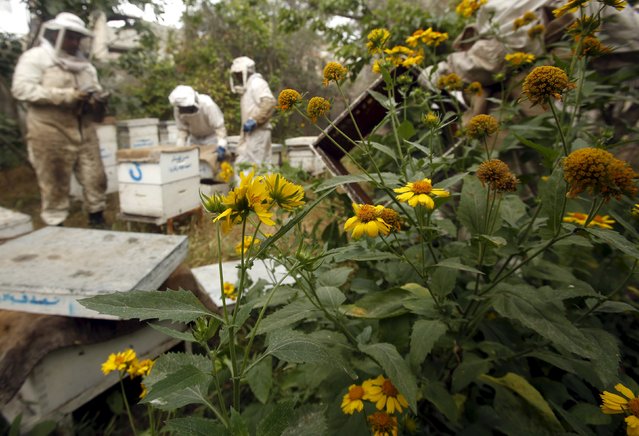
Palestinian beekeepers move beehives in the process of collecting honey at a farm in Rafah, in the southern Gaza Strip April 11, 2016. Rateb Samour sees 250 patients a day, whose complaints range from hair loss to cerebral palsy and cancer. He is not a doctor and has never worked in a hospital. Samour inherited the skill of bee-sting therapy from his father. From 2003 the agricultural engineer dedicated all his time to study and develop the alternative-medicine treatment of apitherapy, which uses bee-related products from honey, propolis – or bee glue used to build hives – to venom. (Photo by Suhaib Salem/Reuters)
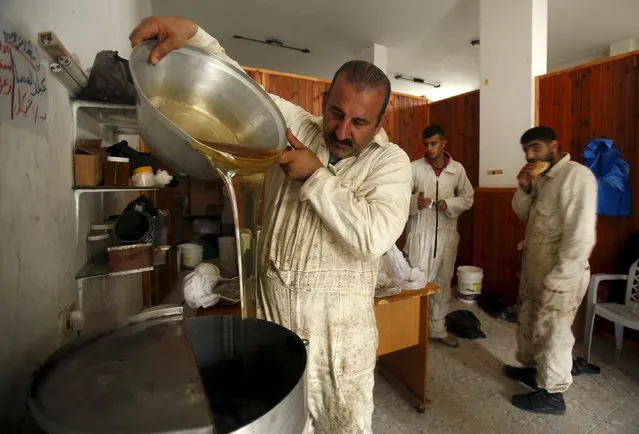
A Palestinian beekeeper pours freshly collected honey into a container at a store in Rafah, in the southern Gaza Strip April 11, 2016. (Photo by Suhaib Salem/Reuters)
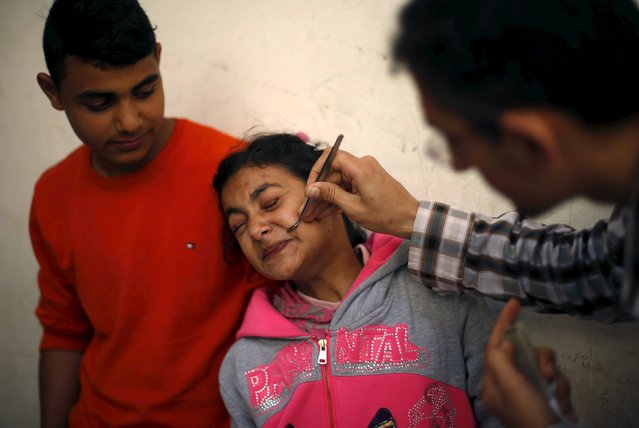
Palestinian girl Alya Al-Ghafari, who suffers from facial palsy, receives bee-sting therapy at Rateb Samour's clinic in Gaza City April 11, 2016. (Photo by Suhaib Salem/Reuters)
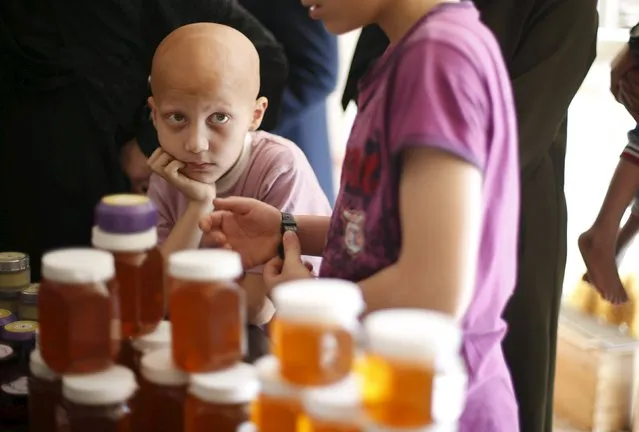
A Palestinian boy, who suffers from alopecia areata, waits to receive bee-sting therapy at Rateb Samour's clinic in Gaza City April 11, 2016. (Photo by Suhaib Salem/Reuters)
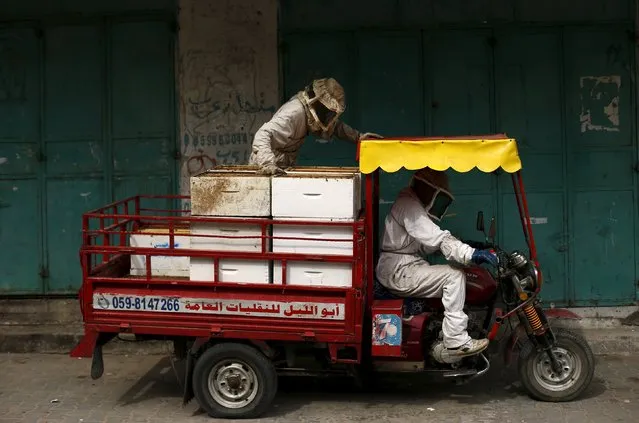
Palestinian beekeepers ride a rickshaw motorbike loaded with honeycombs as they make their way to collect honey at a store in Rafah, in the southern Gaza Strip April 11, 2016. (Photo by Suhaib Salem/Reuters)
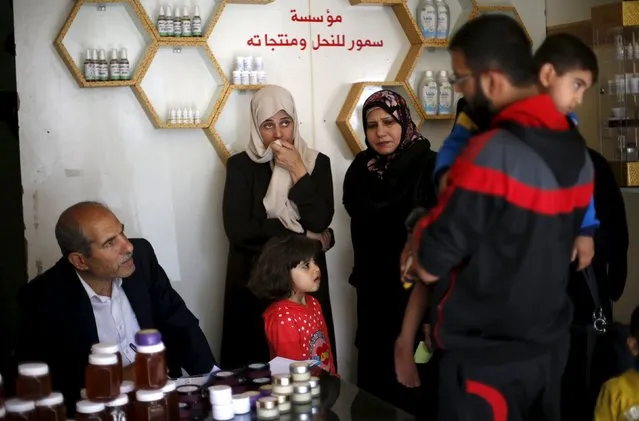
Palestinian agricultural engineer Rateb Samour (L), who treats people with bee-sting therapy, speaks with patients at his clinic in Gaza City April 11, 2016. (Photo by Suhaib Salem/Reuters)
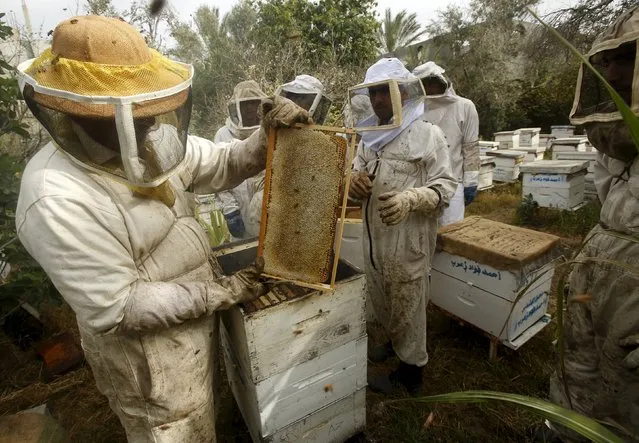
A Palestinian beekeeper carries a honeycomb in the process of collecting honey at a farm in Rafah, in the southern Gaza Strip April 11, 2016. (Photo by Suhaib Salem/Reuters)
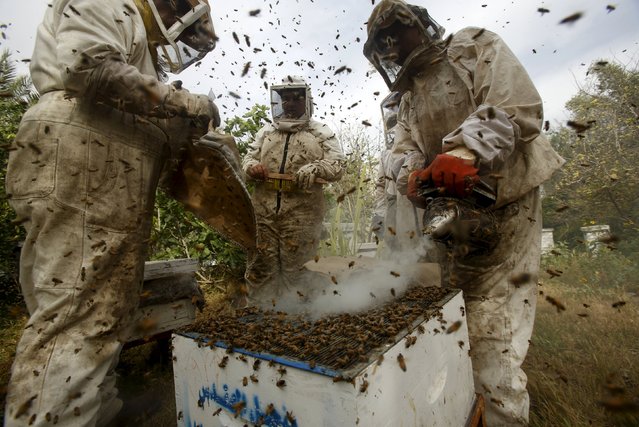
A Palestinian beekeeper uses smoke to calm bees in the process of collecting honey at a farm in Rafah, in the southern Gaza Strip April 11, 2016. (Photo by Suhaib Salem/Reuters)
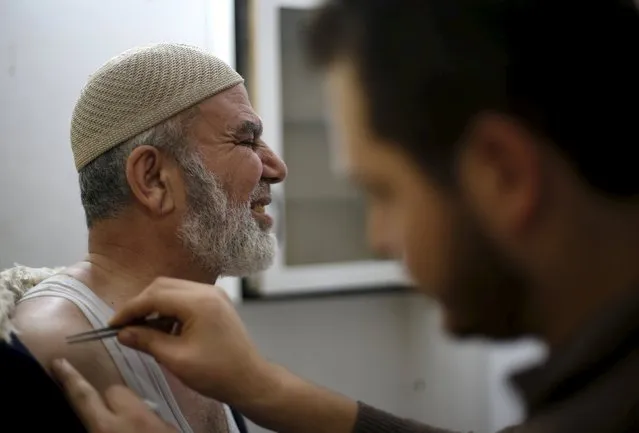
A Palestinian man, who suffers from shoulder pains, receives bee -sting therapy at Rateb Samour's clinic in Gaza City April 11, 2016. (Photo by Suhaib Salem/Reuters)

Palestinian beekeepers move beehives in the process of collecting honey at a farm in Rafah, in the southern Gaza Strip April 11, 2016. Rateb Samour sees 250 patients a day, whose complaints range from hair loss to cerebral palsy and cancer. He is not a doctor and has never worked in a hospital. Samour inherited the skill of bee-sting therapy from his father. From 2003 the agricultural engineer dedicated all his time to study and develop the alternative-medicine treatment of apitherapy, which uses bee-related products from honey, propolis – or bee glue used to build hives – to venom. (Photo by Suhaib Salem/Reuters)

A Palestinian beekeeper pours freshly collected honey into a container at a store in Rafah, in the southern Gaza Strip April 11, 2016. (Photo by Suhaib Salem/Reuters)

Palestinian girl Alya Al-Ghafari, who suffers from facial palsy, receives bee-sting therapy at Rateb Samour's clinic in Gaza City April 11, 2016. (Photo by Suhaib Salem/Reuters)

A Palestinian boy, who suffers from alopecia areata, waits to receive bee-sting therapy at Rateb Samour's clinic in Gaza City April 11, 2016. (Photo by Suhaib Salem/Reuters)

Palestinian beekeepers ride a rickshaw motorbike loaded with honeycombs as they make their way to collect honey at a store in Rafah, in the southern Gaza Strip April 11, 2016. (Photo by Suhaib Salem/Reuters)

Palestinian agricultural engineer Rateb Samour (L), who treats people with bee-sting therapy, speaks with patients at his clinic in Gaza City April 11, 2016. (Photo by Suhaib Salem/Reuters)

A Palestinian beekeeper carries a honeycomb in the process of collecting honey at a farm in Rafah, in the southern Gaza Strip April 11, 2016. (Photo by Suhaib Salem/Reuters)

A Palestinian beekeeper uses smoke to calm bees in the process of collecting honey at a farm in Rafah, in the southern Gaza Strip April 11, 2016. (Photo by Suhaib Salem/Reuters)

A Palestinian man, who suffers from shoulder pains, receives bee -sting therapy at Rateb Samour's clinic in Gaza City April 11, 2016. (Photo by Suhaib Salem/Reuters)
13 Apr 2016 09:14:00,
post received
0 comments
